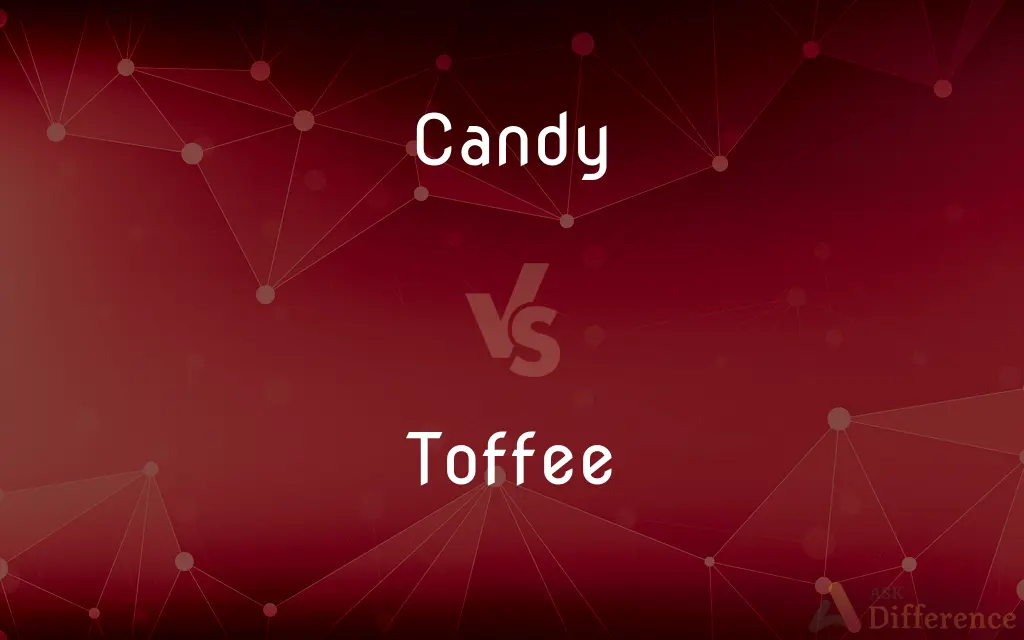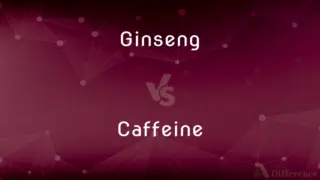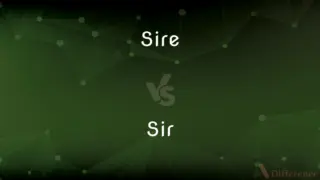Candy vs. Toffee — What's the Difference?
By Tayyaba Rehman & Urooj Arif — Updated on April 17, 2024
Candy is a broad category that includes sweets made from sugar and other flavorings, while toffee is a specific type of candy that is made by caramelizing sugar or molasses along with butter, and sometimes flour, to a hard, chewy texture.

Difference Between Candy and Toffee
Table of Contents
ADVERTISEMENT
Key Differences
Candy encompasses a wide range of confections primarily made from sugar, which can be crystalline (like hard candies) or amorphous (like caramels). Whereas toffee specifically refers to a caramelized candy made from sugar and butter that results in a hard, brittle texture when cooled.
The process of making candy can vary significantly depending on the type; it might involve boiling sugar to different temperatures, adding flavors, and molding. On the other hand, toffee preparation specifically involves cooking sugar and butter to the hard crack stage, which creates its characteristically crunchy texture.
In terms of texture, candies can range from soft and chewy to hard and brittle. Toffee, however, is typically hard and often sticky, intended to be chewed slowly or allowed to dissolve in the mouth.
Flavor variations in candy are nearly limitless, incorporating fruits, nuts, chocolate, and a multitude of flavorings. Toffee's flavor is predominantly the rich, buttery caramel taste, though it can also include nuts or be coated with chocolate.
While candy is enjoyed worldwide in various forms and flavors, toffee holds a special place in British confectionery, known for its traditional recipes and regional variations like buttercrunch and honeycomb.
ADVERTISEMENT
Comparison Chart
Base Ingredients
Sugar, water, various flavorings
Sugar, butter, sometimes molasses or flour
Texture Variants
Can be soft, chewy, hard, or brittle
Generally hard and chewy
Cooking Process
Varies by type (soft ball to hard crack stage)
Cooked to hard crack stage
Flavor Variations
Extremely diverse, from sour to sweet
Rich, buttery, sometimes with nuts or chocolate
Cultural Significance
Popular globally in various forms
Particularly noted in British cuisine
Compare with Definitions
Candy
A sweet food made primarily of sugar.
He bought a bag of mixed candy for the movie.
Toffee
A hard, chewy sweet made by caramelizing sugar with butter.
Toffee is her favorite because of its buttery taste.
Candy
Confections that include ingredients like chocolate, fruits, and nuts.
The candy shop offers everything from gummy bears to artisan chocolates.
Toffee
A candy that often sticks to the teeth, enjoyed slowly.
He savored the toffee, letting it dissolve slowly.
Candy
Small pieces of sweetened flavorings, often enjoyed as snacks.
During Halloween, children collect a wide variety of candy.
Toffee
A traditional sweet particularly popular in the UK.
On her trip to England, she tried several types of traditional toffee.
Candy
A dessert option often given as a treat or gift.
She received a box of candy on Valentine’s Day.
Toffee
Often combined with nuts or coated in chocolate.
The almond toffee was covered in a layer of dark chocolate.
Candy
A term used to describe something that is appealingly superficial.
The movie was pure eye candy with its stunning visuals.
Toffee
Known for its rich, caramel flavor and brittle texture.
The brittle toffee snapped easily into pieces.
Candy
Candy, also called sweets (British English) or lollies (Australian English, New Zealand English), is a confection that features sugar as a principal ingredient. The category, called sugar confectionery, encompasses any sweet confection, including chocolate, chewing gum, and sugar candy.
Toffee
Toffee is a confection made by caramelizing sugar or molasses (creating inverted sugar) along with butter, and occasionally flour. The mixture is heated until its temperature reaches the hard crack stage of 149 to 154 °C (300 to 310 °F).
Candy
A rich sweet confection made with sugar and often flavored or combined with fruits or nuts.
Toffee
A kind of firm or hard sweet which softens when sucked or chewed, made by boiling together sugar and butter, often with other ingredients or flavourings added
A pound of walnut toffee
Candy
A piece of such a confection.
Toffee
Nonsense; rubbish
Please don't expect me to fall for this load of old toffee
Candy
(Slang) An illicit drug, especially one, such as cocaine, that has a sugary appearance or a drug in pill form, such as MDMA.
Toffee
A hard, chewy candy made of brown sugar or molasses and butter.
Candy
To cook, preserve, saturate, or coat with sugar or syrup
Candy apples.
Candy ginger.
Toffee
(uncountable) a type of confectionery made by boiling sugar (or treacle, etc) with butter or milk, then cooling the mixture so that it becomes hard
Candy
Edible, sweet-tasting confectionery containing sugar, or sometimes artificial sweeteners, and often flavored with fruit, chocolate, nuts, herbs and spices, or artificial flavors.
Toffee
(countable) a small, individual piece of toffee
A box of toffees
Candy
A piece of confectionery of this kind.
Toffee
(Northern England) any kind of sweets; candy
Candy
Crack cocaine.
Toffee
(transitive) To coat in toffee.
Candy
(uncountable) An accessory (bracelet, etc.) made from pony beads, associated with the rave scene.
Candy kid; candy raver
Toffee
Taffy.
Candy
(obsolete) A unit of mass used in southern India, equal to twenty maunds, roughly equal to 500 pounds avoirdupois but varying locally.
Toffee
Caramelized sugar cooled in thin sheets
Candy
(cooking) To cook in, or coat with, sugar syrup.
Candy
(intransitive) To have sugar crystals form in or on.
Fruits preserved in sugar candy after a time.
Candy
(intransitive) To be formed into candy; to solidify in a candylike form or mass.
Candy
To conserve or boil in sugar; as, to candy fruits; to candy ginger.
Candy
To make sugar crystals of or in; to form into a mass resembling candy; as, to candy sirup.
Candy
To incrust with sugar or with candy, or with that which resembles sugar or candy.
Those frosts that winter bringsWhich candy every green.
Candy
To have sugar crystals form in or on; as, fruits preserved in sugar candy after a time.
Candy
To be formed into candy; to solidify in a candylike form or mass.
Candy
Any sweet, more or less solid article of confectionery, especially those prepared in small bite-sized pieces or small bars, having a wide variety of shapes, consistencies, and flavors, and manufactured in a variety of ways. It is often flavored or colored, or covered with chocolate, and sometimes contains fruit, nuts, etc.; it is often made by boiling sugar or molasses to the desired consistency, and than crystallizing, molding, or working in the required shape. Other types may consist primarily of chocolate or a sweetened gelatin. The term may be applied to a single piece of such confection or to the substance of which it is composed.
Candy
Cocaine.
Candy
A weight, at Madras 500 pounds, at Bombay 560 pounds.
Candy
A rich sweet made of flavored sugar and often combined with fruit or nuts
Candy
Coat with something sweet, such as a hard sugar glaze
Common Curiosities
Can candy include toffee?
Yes, toffee is a type of candy.
Is toffee harder than most candies?
Typically, yes, toffee is cooked to a hard crack stage, making it harder and chewier than many other candies.
How are candy and toffee flavored?
Candy can include a wide range of flavors from various ingredients, whereas toffee's flavor primarily comes from the caramelization of sugar and butter.
Can you make toffee without dairy?
Yes, there are vegan versions of toffee that use substitutes like coconut oil or vegan butter.
What is the main difference between candy and toffee?
Candy is a general category of sweets primarily made from sugar, while toffee is a specific type of hard, chewy candy made by caramelizing sugar with butter.
Can people with allergies eat toffee?
Those with dairy allergies should avoid toffee since it contains butter, a common allergen.
How is toffee traditionally served?
Toffee is often served as a treat on its own or as part of a dessert, such as in toffee pudding or as a topping.
What are the key ingredients in toffee?
The key ingredients in toffee are sugar and butter, and sometimes molasses or flour for different variations.
Is toffee considered a luxury candy?
In some cultures, particularly in the UK, toffee is considered a traditional luxury treat.
What makes British toffee unique?
British toffee often includes specific recipes and traditional methods, such as the addition of treacle or licorice.
What are some popular variations of toffee?
Popular variations include buttercrunch toffee, which includes almonds, and honeycomb toffee, known for its light, airy texture.
Are there any health concerns with consuming toffee?
Like other candies, toffee is high in sugar and calories, and it can be sticky, which may affect dental health.
What is the best way to store toffee?
Toffee should be stored in a cool, dry place in an airtight container to keep it from becoming sticky or too hard.
Is toffee popular during any particular season?
Toffee is particularly popular during the winter holidays and as a gift item in festive seasons.
How did toffee originate?
Toffee's origins are traced back to early 19th century Britain, where sugar and butter were cooked together to form this confection.
Share Your Discovery

Previous Comparison
Ginseng vs. Caffeine
Next Comparison
Sire vs. SirAuthor Spotlight
Written by
Tayyaba RehmanTayyaba Rehman is a distinguished writer, currently serving as a primary contributor to askdifference.com. As a researcher in semantics and etymology, Tayyaba's passion for the complexity of languages and their distinctions has found a perfect home on the platform. Tayyaba delves into the intricacies of language, distinguishing between commonly confused words and phrases, thereby providing clarity for readers worldwide.
Co-written by
Urooj ArifUrooj is a skilled content writer at Ask Difference, known for her exceptional ability to simplify complex topics into engaging and informative content. With a passion for research and a flair for clear, concise writing, she consistently delivers articles that resonate with our diverse audience.















































